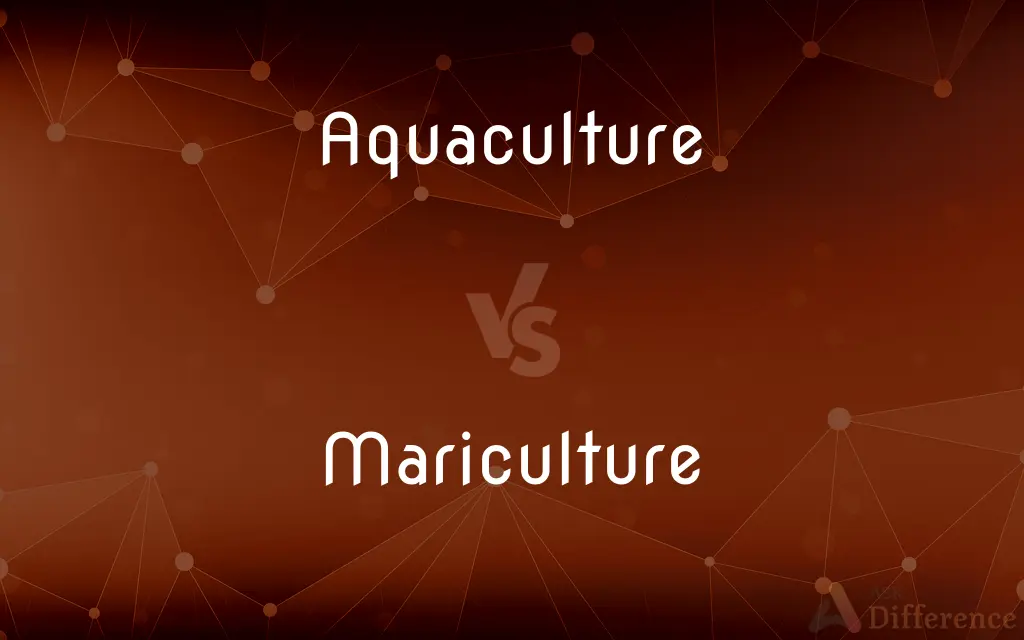Aquaculture vs. Mariculture — What's the Difference?
By Tayyaba Rehman — Updated on October 30, 2023
Aquaculture is the cultivation of aquatic organisms in controlled environments; mariculture is aquaculture specifically in marine environments.

Difference Between Aquaculture and Mariculture
Table of Contents
ADVERTISEMENT
Key Differences
Aquaculture encompasses the breeding, rearing, and harvesting of plants and animals in all types of water environments including ponds, rivers, lakes, and the ocean. It is an umbrella term that includes any aquatic cultivation.
Mariculture, a specialized branch of aquaculture, refers specifically to the cultivation of marine organisms for food and other products in the open ocean, an enclosed section of the ocean, or in tanks, ponds, or raceways which are filled with seawater. It involves marine species and operates in saltwater environments.
The scope of aquaculture is broader than that of mariculture. Aquaculture includes the cultivation of freshwater species like trout and tilapia, in addition to marine organisms. Mariculture is essentially a type of aquaculture but is limited to marine species such as oysters, seaweed, and finfish like salmon when they are farmed in saltwater.
Both practices share techniques and goals, such as increasing seafood production and sustainability. However, the environmental considerations vary greatly. Aquaculture must consider freshwater ecosystems while mariculture deals with the complexities of marine ecosystems.
Lastly, the scale and type of operations between aquaculture and mariculture can differ. Aquaculture can be practiced by hobbyists to large-scale commercial farms, while mariculture often requires more specialized knowledge of marine systems and is typically at a commercial scale.
ADVERTISEMENT
Comparison Chart
Environment
Freshwater and marine.
Strictly marine environments.
Types of Organisms
Both freshwater and marine organisms.
Only marine organisms.
Salinity
Freshwater, brackish, or saltwater.
Saltwater only.
Scope
Broad scope including all aqua farming.
Subset of aquaculture, specific to marine.
Example
Catfish farming in ponds.
Oyster farming in ocean cages.
Compare with Definitions
Aquaculture
Breeding, rearing, and harvesting.
Through aquaculture, they provide sustainably farmed salmon.
Mariculture
Sea-based aquaculture.
Mariculture often involves the farming of shellfish.
Aquaculture
Aquatic agriculture.
Aquaculture is an alternative to overfishing natural populations.
Mariculture
Oceanic food production.
Mariculture helps meet the global demand for fish without depleting wild stocks.
Aquaculture
Cultivation of aquatic organisms.
The aquaculture facility raises both fish and shrimp.
Mariculture
Cultivation in the ocean.
They started a mariculture operation for seaweed production.
Aquaculture
Farming in water.
Aquaculture includes both saltwater and freshwater species.
Mariculture
Marine farming techniques.
Advancements in mariculture improve sustainability.
Aquaculture
Production of seafood.
The aquaculture industry is growing as demand for seafood increases.
Mariculture
Saltwater organism farming.
Mariculture includes the cultivation of pearls.
Aquaculture
Aquaculture (less commonly spelled aquiculture), also known as aquafarming, is the controlled cultivation ("farming") of aquatic organisms such as fish, crustaceans, mollusks, algae and other organisms of value such as aquatic plants (e.g. lotus).
Mariculture
Mariculture or marine farming is a specialized branch of aquaculture (which includes freshwater aquaculture) involving the cultivation of marine organisms for food and other animal products, in enclosed sections of the open ocean (offshore mariculture), fish farms built on littoral waters (inshore mariculture), or in artificial tanks, ponds or raceways which are filled with seawater (onshore mariculture). An example of the latter is the farming of marine fish, including finfish and shellfish like prawns, or oysters and seaweed in saltwater ponds.
Aquaculture
The cultivation of marine or freshwater organisms, especially food fish or shellfish such as salmon or oysters, under controlled conditions. Also called aquafarming.
Mariculture
Cultivation of marine organisms in their natural habitats, usually for commercial purposes.
Aquaculture
The cultivation of aquatic produce such as aquatic plants, fish, and other aquatic animals.
Mariculture
Aquaculture using seawater
Aquaculture
The cultivation of aquatic animals, such as fish or shellfish, or of plants, such as seaweed, in a controlled and sometimes enclosed body of water. The term includes use of either salt or fresh water. It is a form of agriculture, but under water.
Aquaculture
Rearing aquatic animals or cultivating aquatic plants for food
Common Curiosities
What are the benefits of aquaculture?
It provides sustainable seafood, supports conservation, and boosts economies.
What is aquaculture?
Aquaculture is the farming of aquatic organisms in various water environments.
Can aquaculture be practiced in the ocean?
Yes, when aquaculture is practiced in the ocean, it's referred to as mariculture.
How does mariculture differ from aquaculture?
Mariculture is specifically the farming of marine life in saltwater environments.
Is mariculture limited to fish farming?
No, it also includes the cultivation of plants and other marine organisms.
Are all aquaculture systems man-made?
Aquaculture systems can be man-made or natural bodies of water.
What’s a common challenge in aquaculture?
Managing water quality and diseases are common challenges.
Can mariculture affect local ecosystems?
Yes, it can have impacts if not managed sustainably.
Are aquaculture products safe to eat?
Yes, when properly managed, they are safe and nutritious.
Does mariculture only happen in the open sea?
No, it can occur in the open sea, in enclosed parts of the ocean, or in tanks with seawater.
Is aquaponics a type of aquaculture?
Yes, aquaponics combines fish farming with plant cultivation in water.
Do aquaculture and mariculture compete with wild fisheries?
They can, but they also have the potential to complement and relieve pressure on wild fisheries.
Can mariculture improve marine biodiversity?
It has the potential to if it increases habitats and is practiced sustainably.
What type of water do you need for aquaculture?
Aquaculture can use fresh, brackish, or saltwater, depending on the species.
Does mariculture contribute to the economy?
Yes, it can be a significant economic driver, especially in coastal communities.
Share Your Discovery

Previous Comparison
Data vs. Knowledge
Next Comparison
Camisole vs. SlipAuthor Spotlight
Written by
Tayyaba RehmanTayyaba Rehman is a distinguished writer, currently serving as a primary contributor to askdifference.com. As a researcher in semantics and etymology, Tayyaba's passion for the complexity of languages and their distinctions has found a perfect home on the platform. Tayyaba delves into the intricacies of language, distinguishing between commonly confused words and phrases, thereby providing clarity for readers worldwide.















































